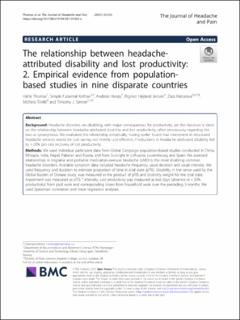| dc.description.abstract | Background Headache disorders are disabling, with major consequences for productivity, yet the literature is silent on the relationship between headache-attributed disability and lost productivity, often erroneously regarding the two as synonymous. We evaluated the relationship empirically, having earlier found that investment in structured headache services would be cost saving, not merely cost-effective, if reductions in headache-attributed disability led to > 20% pro rata recovery of lost productivity. Methods We used individual participant data from Global Campaign population-based studies conducted in China, Ethiopia, India, Nepal, Pakistan and Russia, and from Eurolight in Lithuania, Luxembourg and Spain. We assessed relationships in migraine and probable medication-overuse headache (pMOH), the most disabling common headache disorders. Available symptom data included headache frequency, usual duration and usual intensity. We used frequency and duration to estimate proportion of time in ictal state (pTIS). Disability, in the sense used by the Global Burden of Disease study, was measured as the product of pTIS and disability weight for the ictal state. Impairment was measured as pTIS * intensity. Lost productivity was measured as lost days (absence or < 50% productivity) from paid work and corresponding losses from household work over the preceding 3 months. We used Spearman correlation and linear regression analyses. Results For migraine, in a linear model, we found positive associations with lost paid worktime, significant (p < 0.05) in many countries and highly significant (p < 0.001) in some despite low values of R2 (0–0.16) due to high variance. With lost household worktime and total lost productivity (paid + household), associations were highly significant in almost all countries, although still with low R2 (0.04–0.22). Applying the regression equations for each country to the population mean migraine-attributed disability, we found pro rata recoveries of lost productivity in the range 16–56% (> 20% in all countries but Pakistan). Analysing impairment rather than disability increased variability. For pMOH, with smaller numbers, associations were generally weaker, occasionally negative and mostly not significant. Conclusion Relief of disability through effective treatment of migraine is expected, in most countries, to recover > 20% pro rata of lost productivity, above the threshold for investment in structured headache services to be cost saving. | en_US |

